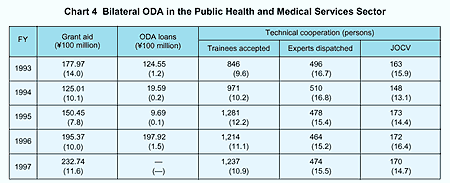Official Development Assistance (ODA)
4. Health Care (1): Primary Health Care and the Future Shape of Health-Care Assistance
1. Primary Health Care
At the Alma Ata (current-day Republic of Kazakhstan) international conference on primary health care, which convened in 1978, the World Health Organization (WHO) and UNICEF proposed a new concept of primary health care (PHC). 11 The Alma Ata conference proved to be a turning point in the history of health-care policy. Backed by the fundamental tenet that health is a basic human right for which disparities or inequalities should not be allowed, it culminated with a call for citizen-led activities at the regional level in public hygiene, health education, maternal and child health care, and family planning. Accepting that challenge, in 1981 the 34th WHO General Conference drew up a set of global targets aimed at improving health for all by the year 2000.
Figures in parentheses represent the respective shares of overall grant aid (excluding grant aid for debt relief, non-project grant aid and grant assistance for grassroots projects), total ODA loans (excluding rescheduling), or shares of overall technical cooperation. Grant aid and ODA loans are on an E/N basis; technical cooperation is on JICA basis.
Japanese aid policy began placing more priority on PHC in the 1970s, beginning with a PHC-related project in Nepal. Since then, Japan has been an active donor of aid in the PHC field, albeit while striving to show respect for the self-help efforts of recipient developing countries. As a consequence, PHC-related undertakings have accounted for a steadily widening share of all Japanese health-care projects: climbing from 8 percent in 1985 to 13 percent in 1990 and 26 percent in 1995.
Most Japanese assistance in this area has been focused on strengthening the capacity of regional hospitals and health centers engaged in the provision of PHC services, and in programs of personnel training and expertise support. Japan is now pursuing various PHC aid projects that incorporate efforts to address an array of new themes, including poverty and disease, WID issues, and emerging and reemerging infectious diseases.
2. The Future Shape of Assistance
Future Japanese health-care assistance, including the promotion of PHC, should place priority in the following areas.
- The provision of highly efficient primary health care services (essential clinical package)
Continued efforts will be necessary to put PHC services within reach for a larger number of people. In particular, to reinforce basic health-care services, it will be essential to encourage a shift from sophisticated tertiary forms of care to primary services, especially in least less-developed countries (LLDCs) and other countries that have not been able to invest significantly in the health-care field. Regional inequalities count as another issue that will demand closer attention within the context of fostering PHC. In regions where PHC has been slow to find acceptance or take firm root (notably in parts of Africa and South Asia), priority will be placed on technical cooperation and the formulation of model projects that will aid the promotion and spread of PHC. By contrast, in regions or countries that have made a measure of progress in adopting and applying PHC principles, priority will be placed on efforts backed by technical cooperation to strengthen health care systems and improve the quality of health care itself. In fact, strengthened regional health care systems will be pivotal to the goal of fostering the dissemination of PHC policies and principles at the local level. To that end, though, it will be important to assign the front line hospitals (prefectural and community hospitals) a stronger role and at the same time devise referral systems 12 that allow for more effective care by them at higher and lower levels of the health care system. - The creation of sustainable systems (based on the cost-sharing principle)
From the standpoint of sustainability, systems founded on the cost-sharing principle will be critically important. Expertise and other soft forms of support will conceivably be increasingly essential to the formulation of fee scales commensurate with the ability of patients to pay, and to the establishment of frameworks for health-care facility cooperation at the community level. To that end, closer collaboration with NGOs will be necessary. - Utilization of local resources
To provide effective aid and sustainable benefits, it will be vital to utilize locally available manpower and resources, and employ appropriate technologies that are suited to local environmental conditions and social infrastructure and acceptable in terms of their costs and the level of care they afford. - Remote health-care services
Improved means of transportation and communication have set the stage for enhancements in the provision of health-care services to remote areas (remote instruction and education, the spread of health-care centers to isolated areas, and the expanded reach of mobile services). Nonetheless, finding enough skilled personnel and developing needed organizational frameworks together rate as issues that will demand continued study, in conjunction with the provision of expertise support on the basis of technical cooperation.
- Primary health care (PHC) is essential health care based on practical, scientifically sound and socially acceptable methods and technology made universally accessible to individuals and families in the community through their full participation and at a cost that the community and country can afford to maintain at every stage of development in the spirit of self-reliance and self-determination. PHC comprises eight elements: (i) health education, (ii) improved food supply and nutrition, (iii) safe water supply and public health management (iv) maternal and child health (including family planning programs), (v) Expanded Program on Immunization, (vi) prevention and control of local epidemic diseases, (vii) appropriate treatment of common diseases and injuries, and (viii) provision of essential drugs.
- Systems whereby higher-level institutions (e.g., prefectural hospitals) perform examinations and provide care for patients on the basis of referrals from lower-level institutions (e.g., community health centers) that are unable to provide such care.

